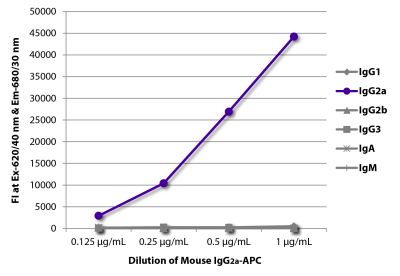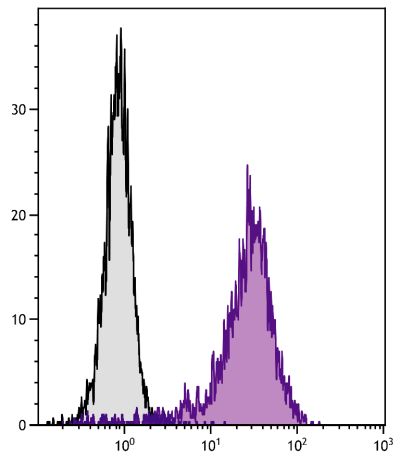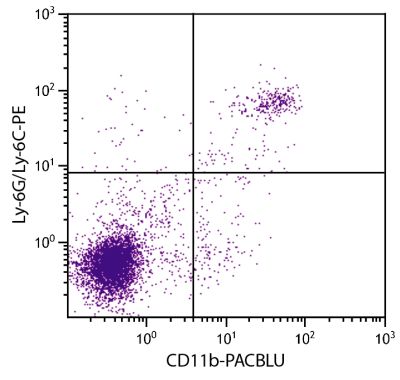Mouse Anti-Mouse NK1.1-APC (PK136)
Cat. No.:
1805-11
APC Anti-Mouse NK1.1 antibody for use in flow cytometry assays.
$301.00
| Clone | PK136 |
|---|---|
| Isotype | Mouse (C3H x BALB/c) IgG2aκ |
| Isotype Control | Mouse IgG2a-APC (HOPC-1) |
| Specificity | Mouse NK1.1 |
| Alternative Names | Ly-55, CD161b/CD161c |
| Description | NK1.1, a member of the NKR-P1 family of cell surface receptors, is a type II integral membrane glycoprotein with a C-type lectin domain. It is expressed as a disulfide-linked homodimer on all NK cells as well as subsets of thymocytes and peripheral T lymphocytes in selected strains of mice (e.g., C57BL/6, NZB, and CE). NK1.1 mediates cellular activation and differentiation, and is thought to have a particular role in generating Th2 cells. This product does not react with NK cells of BALB/c mice. |
| Immunogen | CE mouse spleen enriched for NK-1+ cells and bone marrow cells |
| Conjugate | APC (Allophycocyanin) |
| Buffer Formulation | Phosphate buffered saline containing < 0.1% sodium azide and a stabilizer |
| Clonality | Monoclonal |
| Concentration | 0.1 mg/mL |
| Volume | 1.0 mL |
| Recommended Storage | 2-8°C; Avoid exposure to light; Do not freeze |
| Applications |
Flow Cytometry – Quality tested 1,3-5,8,9 Immunohistochemistry –Reported in literature 8 Immunoprecipitation – Reported in literature 3,4 Depletion – Reported in literature 2,7 Complement Mediated Cell Depletion – Reported in literature 5 Blocking – Reported in literature 4 Activation – Reported in literature 6 |
| RRID Number | AB_2795349 |
| Gene ID |
17059 (Mouse) |
| Gene ID Symbol |
Klrb1c (Mouse) |
| Gene ID Aliases | AI462337; CD161; Klrb1b; Ly-59; Ly55c; Ly59; NK-RP1; NK1.1; NKR-P1.9; NKRP1; NKRP140; Nk-1; Nk-1.2; Nk1; Nk1.2; Nkrp1b; Nkrp1c; ly-55c |
| UniProt ID |
P27814 (Mouse |
| UniProt Name |
KLRBC_MOUSE (Mouse) |
Documentation
Certificate of Analysis Lookup
Enter the Catalog Number and Lot Number for the Certificate of Analysis you wish to view
- 1. Koo GC, Peppard JR. Establishment of monoclonal anti-Nk-1.1 antibody. Hybridoma. 1984;3:301-3. (Immunogen, FC)
- 2. Koo GC, Dumont FJ, Tutt M, Hackett J Jr, Kumar V. The NK-1.1(-) mouse: a model to study differentiation of murine NK cells. J Immunol. 1986;137:3742-7. (Depletion)
- 3. Sentman CL, Hackett J Jr, Moore TA, Tutt MM, Bennett M, Kumar V. Pan natural killer cell monoclonal antibodies and their relationship to the NK1.1 antigen. Hybridoma. 1989;8:605-14. (FC, IP)
- 4. Kung SK, Su R, Shannon J, Miller RG. The NKR-P1B gene product is an inhibitory receptor on SJL/J NK cells. J Immunol. 1999;162:5876-87. (FC, IP, Block)
- 5. Karlhofer FM, Yokoyama WM. Stimulation of murine natural killer (NK) cells by a monoclonal antibody specific for the NK1.1 antigen. IL-2-activated NK cells possess additional specific stimulation pathways. J Immunol. 1991;146:3662-73. (FC, CMDC)
- 6. Reichlin A, Yokoyama WM. Natural killer cell proliferation induced by anti-NK1.1 and IL-2. Immunol Cell Biol. 1998;76:143-52. (Activ)
- 7. Sharma N, He Q, Sharma RP. Amelioration of fumonisin B1 hepatotoxicity in mice by depletion of T cells with anti-Thy-1.2. Toxicology. 2006;223:191-201. (Depletion)
- 8. Al-Falahi Y, Sand KL, Knudsen E, Damaj BB, Rolin J, Maghazachi AA. Splenic natural killer cell activity in two models of experimental neurodegenerative diseases. J Cell Mol Med. 2009;13:2693-703. (FC, IHC)
- 9. Freitas CS, Dalmau SR, Abdelhay E. Differential expression of notch signaling-related transcripts accompanies pro-thymocyte proliferation and phenotype transition induced by epidermal growth factor plus insulin in fetal thymus organ cultures. Mem Inst Oswaldo Cruz. 2004;99:381-88. (FC)
See All References






